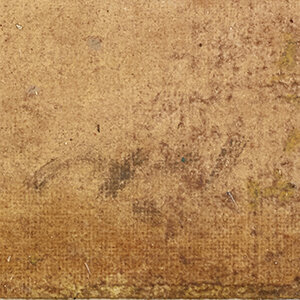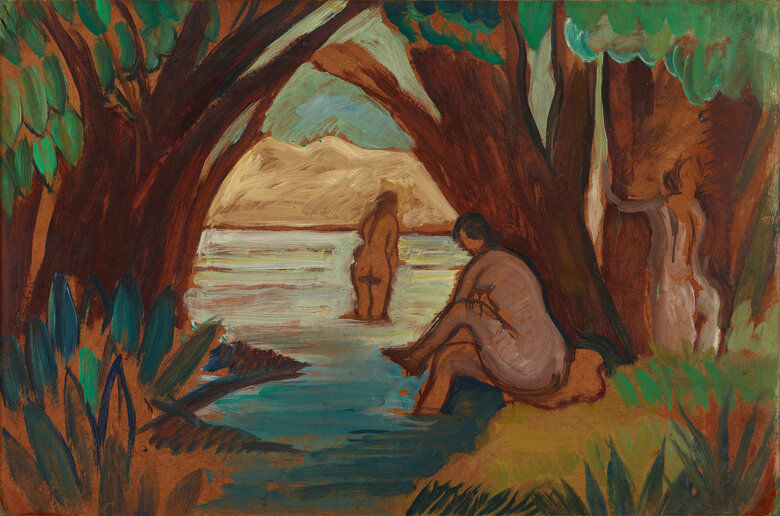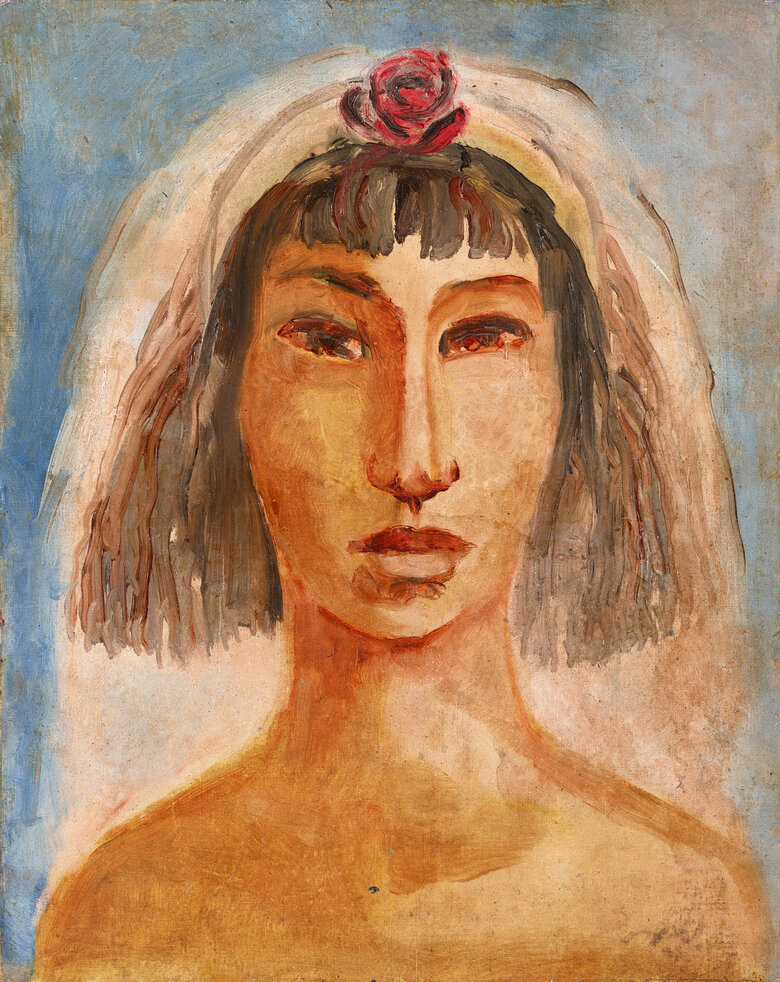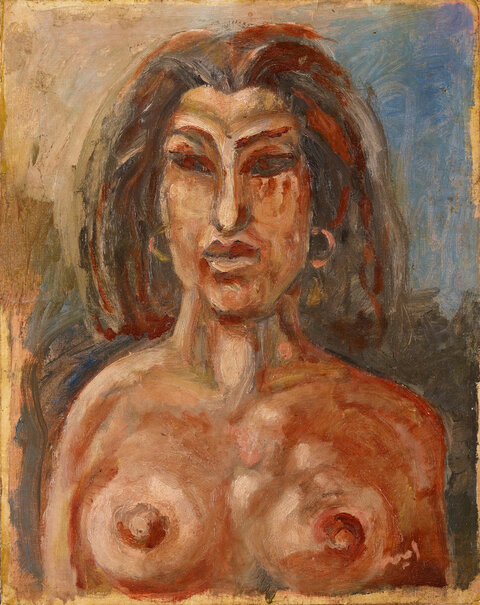Born in 1904 in Cairo to a Turkish official father, Hussein Youssef Amin grew up in a wealthy family, and showed an interest in drawing at an early age. In 1924, he traveled to Italy, where he...


HUSSEIN YOUSSEF AMIN, Egypt (1904 - 1984)
Bio
Written by ARTHUR DEBSI
Born in 1904 in Cairo to a Turkish official father, Hussein Youssef Amin grew up in a wealthy family, and showed an interest in drawing at an early age. In 1924, he traveled to Italy, where he studied painting at the Accademia di Belle Arti in Florence. Graduated in 1930, he started a diplomatic career, which led him to move to Sao Paulo, Brazil, where he settled for several years. However, Amin kept on drawing in parallel, and got inspiration from the popular arts in Brazil. In 1931, he returned to Egypt, and quickly got involved in the local art educational system, by frequenting the Egyptian pedagogue-painters Habib Gogui (1892-1965), and Youssef al-Afifi. With their experiences abroad, these three important figures of teaching, played a key role in their country’s reforms in art education. In Egypt, art education was represented by the great institution of the École des Beaux-Arts in Cairo which provided a European academic art practice. Besides, the teachers were artists coming from France, and Italy. However, as of the 1920s, many associations of Egyptian artists – some of which mainly graduated from the Higher Teacher’s College (Madrasat al-Mu’alimin al-‘Aliyya) – formed, in order to lay the foundations of a new teaching of art, different from the European academic system. In 1937, Hussein Youssef Amin co-founded with the above-mentioned Egyptian pedagogues, the Association des Professeurs de Dessin (Union of Drawing Teachers), which first aimed to renovate the educational system, implementing pedagogical principles to the teaching of drawing. Yet, the political commitment of Hussein Youssef Amin at that time was such, that he had to go into exile in Spain, when the Civil War occurred from 1936 to 1939[1]. Upon his return to Egypt, Amin taught drawing in the Hilmiyya secondary school, in the district of Sayyida Zeinab, during the early 1940s. There, he was captivated by the works of some of his pupils, including Hamed Nada (1924 - 1990), Abdel Hadi El-Gazzar (1925-1966), and Samir Rafi (1926-2004) to name a few. Thus, he decided to offer them a curriculum in his villa located in Maryutiya, nearby the pyramids. Taking them out of the city was a way to apply his methodology, which consisted in keeping these students away from the elitist artistic spheres of Alexandria, and Cairo, and stimulating their self-development.
In 1949, the teacher Hussein Youssef Amin, and his student Abdel Hadi El-Gazzar (1925-1966) were both arrested after the display of The Popular Chorus, originally dated from 1948, and also known under the titles Hunger, or The Theater of Life. Illustrating the social issues of Egypt, the painting was disapproved by the government, which saw it as an affront to its politics. Yet, thanks to the painters Mahmoud Said (1897-1964), and Mohamed Naghi (1888-1956), they were released from their incarceration[2].
In the oeuvre of Hussein Youssef Amin, the detachment from academic art, and the taste for experimentation are noticeable through the plastic treatment, that he used. As a matter of fact, he liked to reinterpret the physical reality, by giving importance to sensitivity, and harmony. In the non-dated work entitled Bathing Nudes, part of the Dalloul Art Foundation’s collection, he depicted a peaceful moment, when three naked women are swimming in a lake. He applied a warm palette of colors, and especially created depth in the composition, by combining the complementary colors green, and orange. Preferring synthetic elements, Amin didn’t render the details of the body parts, and features of the characters, and chose to shape simple silhouettes, that he contoured with thick brown, or black lines. The painter immerses the viewer in an intimate, and sensual scene, unfolding in the shade of the trees. The subject itself had always been recurrent in some modern masterpieces, like Les Baigneuses (1953), by the French painter Gustave Courbet (1819-1877), as well as Les Grandes Baigneuses (1906), painted by Paul Cézanne (1839-1906). Hence, Hussein Youssef Amin showed an interesting point of his artistic theories, which were also based on the work on the local, and the universal. According to him, an aesthetic doesn’t define a nationality, but the art gives a nationality to the subject[3]. Interpreting this theme, Hussein Youssef Amin consequently affirmed the potential of the Egyptian art movement called the Contemporary Art Group (Jama’at al-Fann al-Mu’asir), which would include Egyptian art in the elaboration of international modern art movements.
In 1946, Hussein Youssef Amin, who was inspector of Fine Arts at the Ministry of Public Instruction, co-founded the Contemporary Art Group alongside with his students including Hamed Nada (1924 - 1990), Abdel Hadi El-Gazzar (1925-1966), and Samir Rafi (1926-2004). Unlike the previous art movements from the first half of the 20th century, and bearer of a nationalist program; the Contemporary Art Group aimed to create a narrative, and imaginary in their artworks, which had to include an intellectual dimension, as they stated in the first declaration in 1946: ‘The value of a work of art is proportional to the extent to which it brings thinking and feeling together. (…) We of the Contemporary Art Group have based our idealism on the strong link between art and intellectual thought (…)’[4]. This innovative approach was elaborated according to a philosophy, through which art should be revealing the contemporaneity (mu’asira) of the artists. These artists, by their social backgrounds, were particularly familiarized with the conditions of living of the people, that forged them, with a rebellious point view.
Resulting from the teaching of Hussein Youssef Amin, the members of the Contemporary Art Group refused to conform to an imported European academic style, and its prevalence over their art. For this reason, they were prone to primitivism, with the resurgence of Ancient Egyptian past, and folk culture. Both would render the accurate image of Egypt, and exposed the wide range of its people’s emotions, hopes, and fears. Amin wanted his students, and colleagues to emphasize the psychological dimension of the scene[5]. In the paintings, Untitled, and Portrait, both dated from 1940, and also part of the Dalloul Art Foundation’s collection, he executed two portraits of quite similar bare-chested women. Through the use of thick brushstrokes, and warm colors, he revealed two characters, adopting a hieratic attitude, and staring at the viewer with deep eyes. He tended to express the inner emotions of the figures, who somehow look melancholic. According to their haircut, jewels, as well as their tan complexion, these two women seems to belong to the Egyptian peasant class. The concept of reconnecting to those people from the countryside in Egypt, their culture, and daily life; was a significant leitmotiv, commonly present in the works of the Contemporary Art Group. From his experience in Brazil, Hussein Youssef Amin realized the importance, that can have popular culture in art[6]. He effectively thought that an art related to this type of culture, and to underprivileged social classes, could be a revolutionary art, through an innovative aesthetic, and impactful message[7]. Elevating the portrait of female peasants was a way to assert that peasantry, is the essence of Egyptian identity – not corrupted like the local Westernized elite.
By initiating the Contemporary Art Group, Hussein Youssef Amin proposed another artistic form of expression, which was qualified as a ‘miracle’ by the Lebanese writer, art critic Aimé Azar in his book La Peinture moderne en Égypte, in 1961. Instead of prioritizing the content of the work of art, Amin highly encouraged the development of personal techniques, and approaches. And the fact that, he, and his students freed themselves from mainstream academism, led them to discover, and impose a style, which is the accurate illustration of modern Egypt.
Hussein Youssef Amin passed away in 1984.
Notes
[1] Kane, Patrick. “Egyptian Art Institutions and Art Education from 1908 to 1951,” 2010. https://www.jstor.org/stable/10.5406/jaesteduc.44.3.0043. [P.106]
[2] Karnouk, Liliane. Modern Egyptian Art, 1920-2003. Cairo, New York, Egypt, USA: The American University in Cairo Press, 2005. [P.39]
[3] Karnouk, Liliane. Modern Egyptian Art, 1920-2003. Cairo, New York, Egypt, USA: The American University in Cairo Press, 2005. [P.39]
[4] Contemporary Art Group declaration, from transcript published by Husayn Yusuf Amin in ‘Abd al-Hadi al-Jazzar: Fannan al-Thawra’, al-Majalla, no.124 (April 1967); pp.79-80. Translated from Arabic by Sarah Dorman in Lenssen, Anneka, A. Rogers, Sarah, and Shabout, Nada. Modern Art in the Arab World, Primary Documents. New York, USA: The Museum of Modern Art, 2018. [P.114]
[5] Azar, Aimé. The Awakening of the Pictorial Consciousness in Egypt: the Contemporary Art Group, Cairo, 1954. Excerpt retrieved in Boutros, Nabil, Maria Golia, and Edouard Al Kharrat. Contemporary Art Group, Cairo 1946. [Exhibition catalogue, ‘Art Dubai Modern’. Dubai, Art Dubai, March 22nd – March 24th 2018]. Cairo, Egypt: Karim Francis Galley, 2018.
[6] Kane, Patrick. "Art Education and the Emergence of Radical Art Movements in Egypt: The Surrealists and the Contemporary Arts Group, 1938-1951." The Journal of Aesthetic Education 44, no. 4 (2010): 95-119. Accessed September 10, 2020. https://www.jstor.org/stable/10.5406/jaesteduc.44.4.0095 [P.98]
[7] Karnouk, Liliane. Modern Egyptian Art, 1920-2003. Cairo, New York, Egypt, USA: The American University in Cairo Press, 2005. [P.39]
Sources
Ali, Wijdan. Modern Islamic Art: Development and Continuity. Gainesville, USA: University Press of Florida, 1997.
Bardaouil, Sam, and Fellrath, Till. Art Et Liberté, Rupture, War and Surrealism in Egypt (1938-1948. [Exhibition catalogue, ‘Art Et Liberté, Rupture, Guerre Et Surréalisme En Égypte (1938-1948)’. Paris, Centre Georges Pompidou, October 19th 2016 – January 16th 2017]. Paris, France: Skira, 2016.
Boutros, Nabil, Maria Golia, and Edouard Al Kharrat. Contemporary Art Group, Cairo 1946. [Exhibition catalogue, ‘Art Dubai Modern’. Dubai, Art Dubai, March 22nd – March 24th 2018]. Cairo, Egypt: Karim Francis Galley, 2018.
Didier-Hess, Valerie, and Hussam Rashwan. Mahmoud Said, Catalogue Raisonné. Milan, Italy: Skira, 2015.
Eigner, Saeb. Art of the Middle-East, Modern and Contemporary Art of the Arab World and Iran. London, UK: Merell Publishers Limited, 2011.
Kane, Patrick. "Art Education and the Emergence of Radical Art Movements in Egypt: The Surrealists and the Contemporary Arts Group, 1938-1951." The Journal of Aesthetic Education 44, no. 4 (2010): 95-119. Accessed September 10, 2020. https://www.jstor.org/stable/10.5406/jaesteduc.44.4.0095
Kane, Patrick. “Egyptian Art Institutions and Art Education from 1908 to 1951,” 2010. https://www.jstor.org/stable/10.5406/jaesteduc.44.3.0043.
Karnouk, Liliane. Modern Egyptian Art, 1920-2003. Cairo, New York, Egypt, USA: The American University in Cairo Press, 2005.
Lenssen, Anneka, A. Rogers, Sarah, and Shabout, Nada. Modern Art in the Arab World, Primary Documents. New York, USA: The Museum of Modern Art, 2018.
Mostafa Kanafani, Fatenn. Modern Art in Egypt: Identity and Independence, 1850-1936. London, UK: BLOOMSBURY Publishing, 2020.
Mostafa Kanafani, Fatenn. Uncensored Samir Rafi, [Exhibition Catalogue, ‘Uncensored Samir Rafi’. Cairo, ArtTalks Egypt, September 24th 2019 – November 5th 2019]. Cairo, Egypt: ArtTalks Egypt, 2019.
Radwan, Nadia. Les Modernes D'Egypte: Une Renaissance Des Beaux-Arts Et Des Arts Appliqués (1908-1938). Berne, Switzerland: Peter Lang AG., 2017.
Seggerman, Alex Dika. Modernism on the Nile: Art in Egypt between the Islamic and the Contemporary. Chapel Hill, USA: University of North Carolina Press, 2019.
CV
Selected Solo Exhibitions
2021
Remembered III, Hussein Youssef Amin (1904-1984), Al-Masar Gallery, Cairo, Egypt
Selected Group Exhibitions
2023
Partisans of the Nude: An Arab Art Genre in an Era of Contest, 1920-1960, Wallach Art Gallery, Columbia University Harlem, New York, USA
2021
Contemporary Views XIV, Al-Masar Gallery for Contemporary Art, Cairo, Egypt
2020
Contemporary Views XIII, Al-Masar Gallery for Contemporary Art, Cairo, Egypt
2019
Contemporary Views XII, Al-Masar Gallery for Contemporary Art, Cairo, Egypt
2018
Contemporary Views XI, Al-Masar Gallery for Contemporary Art, Cairo, Egypt
Art et Liberté, Rupture, War and Surrealism in Egypt (1938-1948), Moderna Museet, Stockholm, Sweden
Art et Liberté, Rupture, War and Surrealism in Egypt (1938-1948), Tate Liverpool, Liverpool, United Kingdom
2017
Art et Liberté, Rupture, War and Surrealism in Egypt (1938-1948), Kunstsammlung Nordrhein-Westfalen,Düsseldorf,Germany
Art et Liberté, Rupture, War and Surrealism in Egypt (1938-1948), Museo Nacional Centro de Arte Reina Sofia, Madrid, Spain
2016
The Contemporary Art Group (1946), Al-Masar Gallery, Cairo, Egypt
Art et Liberté, Rupture, guerre et surréalisme en Égypte (1938-1948), Centre Pompidou, Paris, France
2014
Contemporary Views VI, Al-Masar Gallery for Contemporary Art, Cairo, Egypt
2012
Gallery Collection, Al-Masar Gallery for Contemporary Art, Cairo, Egypt
2010
Remembered Late Artist Hussein Youssef Amin, Founder of the Group of Contemporary Art, Al-Masar Gallery for Contemporary Art, Cairo, Egypt
1951
The 1st São Paulo Biennial, São Paulo, Brazil
1949
Exhibition at Y.M.C.A, Cairo, Egypt
1948
Exposition de l’Art Contemporain, Service de la Jeunesse, Cairo, Egypt
1946
First Exhibition of the Contemporary Art Group, Foyer d’Art du Lycée Français, Cairo, Egypt
Affiliations and Memberships
1945
The Contemporary Art Group
1936-
1948
Groupe of Art et Liberté (Art and Liberty)
Awards and Honors
1951
The First Modern Art Prize, The 1st São Paulo Biennial, São Paulo, Brazil
Collections
The Museum of Modern Egyptian Art, Cairo, Egypt
The Ramzi and Saeda Dalloul Art Foundation, Beirut, Lebanon
Press
استعادة دور التشكيلي حسين يوسف أمين في صانع المبدعين - بوابة الأهرام.pdf
_حسين يوسف أمين_..... - Al Masar Gallery _ Contemporary Art _ Facebook.pdf
الأحد.. المعرض الفردى الثالث للفنان الراحل حسين يوسف أمين بجاليرى مسار.pdf
جاليرى المسار يفتتح معرض _جماعة الفن المعاصر 1946_ 16 أكتوبر - اليوم السابع.pdf
الفنان حسين يوسف أمين.. صانع المبدعين.pdf
(#29) Hussein Youssef Amin.pdf
محمد الديب.. يكتب_ حسين يوسف أمين.. رحلة العطاء والإبداع - هاشتاج مصر.pdf
Art et Liberté_ Rupture, War and Surrealism in Egypt (1938-1948) Enterprise.pdf
Art et Liberté_ Rupture, War and Surrealism in Egypt exhibition Enterprise.pdf
On Art and Liberty_harpersbazaararabia.com.pdf
On Mohammad El Rawas’ “The Library” _ Sursock Museum.pdf
Bonhams _ Hussein Youssef Amin (Egypt, 1904-1984) The Dancer and the Zammar.pdf
HUSSEIN YOUSSEF AMIN Artwork
Become a Member
Join us in our endless discovery of modern and contemporary Arab art
Become a Member
Get updates from DAF
Follow Artists
Save your favourite Artworks
Share your perspectives on Artworks
Be part of our community
It's Free!
We value your privacy
TermsCookiesPrivacy Policies
Become a Member
Get updates from DAF
Follow Artists
Save your favourite Artworks
Share your perspectives on Artworks
Be part of our community
It's Free!
We value your privacy
TermsCookiesPrivacy Policies
Become a Member
Get updates from DAF
Follow Artists
Save your favourite Artworks
Share your perspectives on Artworks
Be part of our community
It's Free!
We value your privacy
TermsCookiesPrivacy Policies
Welcome to the Dalloul Art Foundation
Thank you for joining our community
If you have entered your email to become a member of the Dalloul Art Foundation, please click the button below to confirm your email and agree to our Terms, Cookie & Privacy policies.
We value your privacy, see how
Become a Member
Get updates from DAF
Follow Artists
Save your favourite Artworks
Share your perspectives on Artworks
Be part of our community
It's Free!
We value your privacy
TermsCookiesPrivacy Policies








